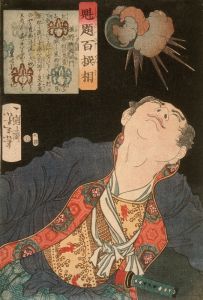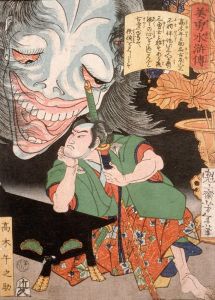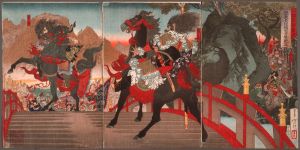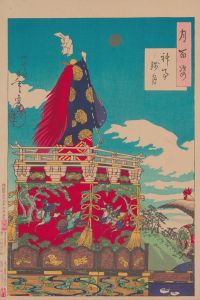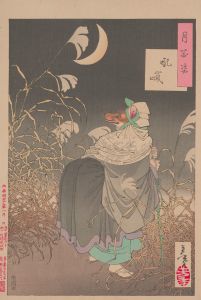
Tadamori and the Oil Thief
A hand-painted replica of Tsukioka Yoshitoshi’s masterpiece Tadamori and the Oil Thief, meticulously crafted by professional artists to capture the true essence of the original. Each piece is created with museum-quality canvas and rare mineral pigments, carefully painted by experienced artists with delicate brushstrokes and rich, layered colors to perfectly recreate the texture of the original artwork. Unlike machine-printed reproductions, this hand-painted version brings the painting to life, infused with the artist’s emotions and skill in every stroke. Whether for personal collection or home decoration, it instantly elevates the artistic atmosphere of any space.
"Tadamori and the Oil Thief" is a woodblock print created by the renowned Japanese artist Tsukioka Yoshitoshi. Yoshitoshi, born in 1839 and deceased in 1892, is often celebrated as one of the last great masters of the ukiyo-e genre of woodblock printing and painting. His works are known for their dramatic intensity, innovative compositions, and the incorporation of Western techniques into traditional Japanese art.
This particular print, "Tadamori and the Oil Thief," is part of Yoshitoshi's series "Tsuki hyakushi" (One Hundred Aspects of the Moon), which he produced between 1885 and 1892. The series consists of 100 prints, each depicting a scene related to the moon, often drawing from Japanese history, folklore, and literature.
The subject of "Tadamori and the Oil Thief" is based on a well-known Japanese legend involving Taira no Tadamori, a samurai of the late Heian period. Tadamori, who lived from 1096 to 1153, served the Emperor Shirakawa and was known for his bravery and loyalty. The legend tells of an incident where Tadamori was ordered to investigate reports of a ghostly figure stealing oil from the lanterns of the Gion Shrine in Kyoto.
According to the story, Tadamori discovered that the so-called ghost was not a supernatural being but a poor monk who was stealing oil to keep his lamp lit. Instead of punishing the monk, Tadamori showed compassion and understanding, revealing his wisdom and humanity. This tale highlights Tadamori's bravery and his ability to see beyond appearances, a theme that resonates with the values of the samurai code.
Yoshitoshi's depiction of this scene captures the moment of revelation, with Tadamori confronting the oil thief. The composition is dynamic, with a strong sense of movement and tension. Yoshitoshi's use of color and line work is masterful, creating a vivid and engaging image that draws the viewer into the story. The moon, a recurring motif in the series, is subtly incorporated into the background, adding a layer of symbolism and atmosphere to the print.
Yoshitoshi's "Tadamori and the Oil Thief" is not only a beautiful work of art but also a cultural artifact that reflects the rich tapestry of Japanese history and folklore. It exemplifies Yoshitoshi's skill in storytelling through visual art and his ability to blend traditional Japanese aesthetics with innovative techniques. This print, like many others in the "One Hundred Aspects of the Moon" series, remains highly regarded by collectors and scholars of Japanese art for its artistic quality and historical significance.









